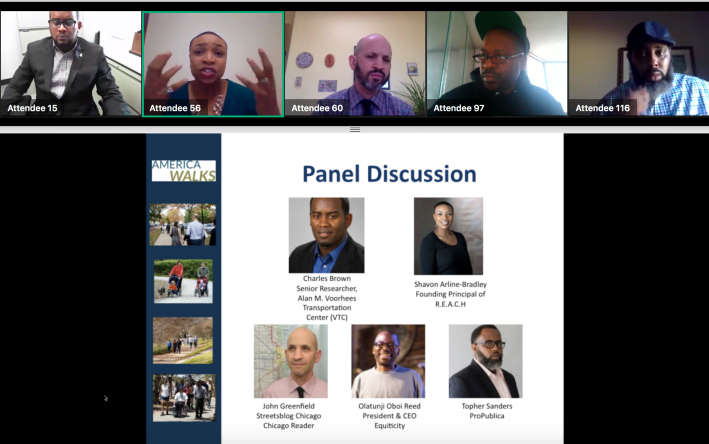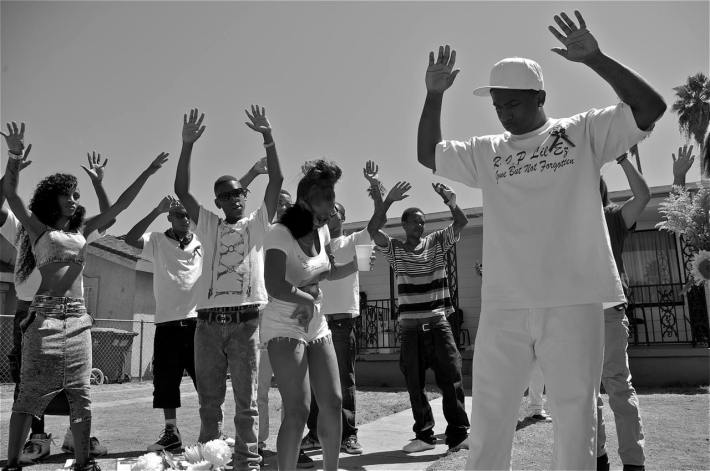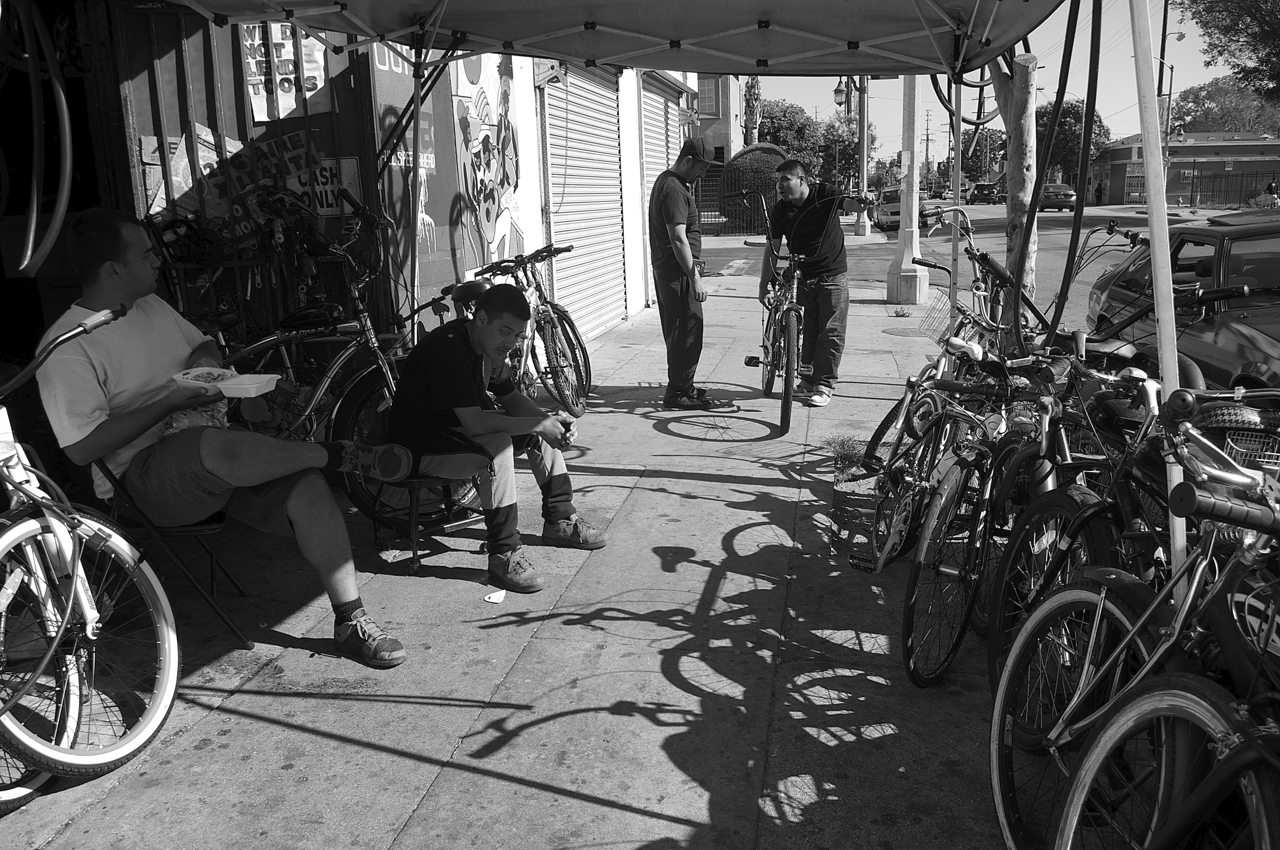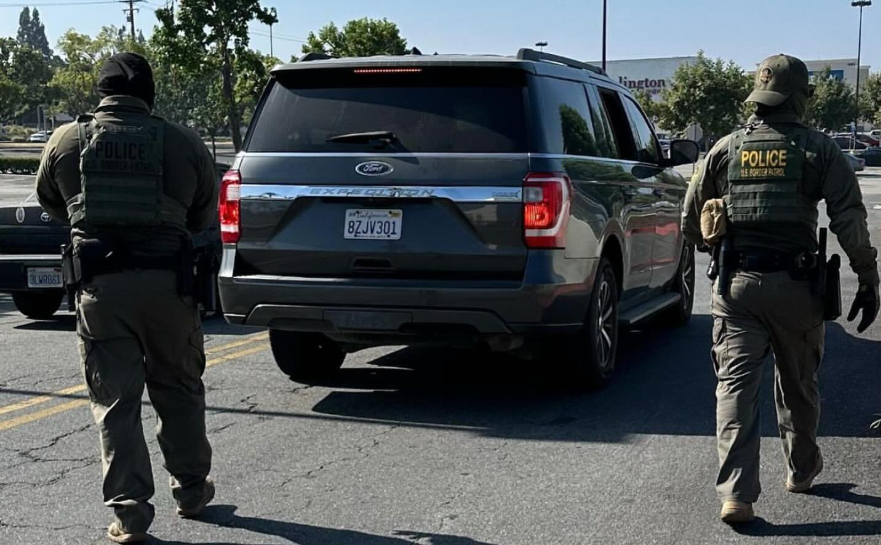Anthony,* a black fixie rider in his early 20s, had been walking his bike in front of his South L.A. home a few years back when the police pulled up to ask what he was doing,
The answer was pretty straightforward: he had just broken his ankle and was unable to ride, so he was taking the bike home to store it.
But despite the obvious injury and the fact that he was in front of his own home, he said, the officers peppered him with questions at length before finally handing him a ticket for riding on the sidewalk.
It's the kind of thing that men and youth of color report happens regularly here in Los Angeles. A ticket - however bogus it may be - validates the stop, makes it more difficult for the recipient to complain about profiling, and puts the recipient into the system, helping justify future detentions and (should the fine go unpaid and turn into a warrant) arrests.
And, as with Anthony, it can leave them feeling humiliated, angry, powerless, and more likely to ignore the citation.
Ignoring it was something he ended up regretting months later, he said, when he was stopped while out riding late one night and police ran his name.
Reluctant to say much more about the trauma of spending so much time in the back of a police car on a dark and deserted stretch of road, however, he sighed and looked down at his hands.
His friends all nodded - they already knew this story well.
The police always singled him out, said the owner of the bike shop where we are all sitting. They had even pulled up to the shop one day, pointed at Anthony as he stood with a group of Latino friends, and ordered him - and only him - up against the wall.
No reason was given, spat the owner. And it took what felt like forever for them to convince the officers that Anthony was a friend, that the owner wanted him there, and that he was doing nothing wrong.
They joked as they recalled how maddening the scene had been.
What else could they do?
"That shit always happens," they shrugged.
Making Space to Talk About “That Sh*t”
The fact that that sh*t does always happen is one of the reasons that Charles Brown, Senior Researcher with the Alan M. Voorhees Transportation Center at Rutgers, included Michelle Alexander's The New Jim Crow: Mass Incarceration in the Age of Colorblindness in the #WalkingTowardJustice webinar series he launched last fall in collaboration with America Walks.

The series itself is, in great part, a response to the stasis within the planning community on issues that have to do with race, historical disenfranchisement, and marginalization. Despite the growing recognition of the need for a more inclusive lens in planning, there is still significant resistance to making a meaningful shift from a white-centered paradigm to a broader justice-oriented one capable of mitigating inequities. Concepts like “equity” and “justice” have gained significant traction in recent years, as has interest in the kind of work Brown has done around barriers to mobility in black and brown communities. But because the actual people whose lives are most heavily circumscribed by the legacy of discriminatory planning practices continue to have the least representation at the table, their struggles and needs still tend to be stripped of intersections and contexts, co-opted, and/or ignored altogether.
In taking on books like Richard Rothstein’s The Color of Law (the subject of Brown’s September webinar on the legacy of planning’s segregationist past), Brown has launched an important challenge to this state of affairs. By calling upon panelists of color with grounding in the communities those books examine, he is able to make the connections between historical context, race, planning, power, inequities, and justice more tangible for listeners. In the process, he provides a template for how to approach these long-overdue conversations in a thoughtful and productive way. And in identifying sources of structural injustices, he makes an implicit call to action, asking planners to actively guard against perpetuating those injustices in their work.
To that end, Alexander’s powerful deconstruction of the criminal justice system provided the perfect backdrop for Brown’s second webinar this past January - a panel discussion on the impact of biased policing on the mobility of marginalized communities and the implications for programs like Vision Zero (where law enforcement is often an implementing partner) - by picking up the conversation where the previous discussion of the legacy of redlining had left off.
In essence, the deployment of law enforcement to maintain dominion over redlined communities had laid the foundations for the criminalization of blackness and poverty, both in practice and in the American imagination. As civil rights protections made it increasingly difficult to curtail the mobility of people of color via explicitly discriminatory approaches, however, Alexander argues, white fear had to be assuaged in other ways.
The coded reframing of “crime” proved very useful in that regard.
Tough “law-and-order” approaches to policing, a “war on drugs,” and various forms of “stop-and-frisk” allowed active discrimination against communities of color to continue largely unabated. Harsher sentencing, the ripping apart of families, and the disenfranchisement and denial of upward mobility to generations of men of color, in turn, helped reinforce the conditions that were then used to justify repressive approaches to policing.
In the process, Alexander explains, blame for this treatment was transferred to the targeted groups themselves. No longer was it whites who were denying blacks rights or access; instead, it was blacks who, time and again, proved themselves incapable of shouldering the burdens and privileges of full citizenship. Fingers were pointed at African Americans’ cultural and behavioral “deficiencies,” said to be rooted in broken family structures, while higher unemployment and crime rates in disenfranchised communities were viewed as confirmation that blacks were “lazy” and inherently more criminal.
Within such a context, the policing of the movement of black bodies through the public space becomes a moral imperative. We know all too well what this looks like in practice today - be it the ticketing of a youth like Anthony for being black on the sidewalk, platitudes about “safe streets” used as an excuse to police a community of color more intensely, or black men dying on our screens for having “wide-set” noses, moving too fast, moving too slow, or not moving at all.
The urgency of this reality and the extent to which law enforcement is increasingly tapped as planning’s silent partner in creating “safe,” “walkable,” and “livable” communities means that this is where the conversation needs to begin. There is no way forward without a genuine reckoning with the costs that structures empowered to benefit whiteness and hold blackness at bay continue to exact from people of color.
But true reckonings within planning remain hard to come by.
As both Brown’s webinars have now managed to make exceedingly clear, progress on that front depends on who gets to frame the conversation.
In the September webinar, panelists and listeners alike were taken aback to hear Richard Rothstein - someone who had spent 300-plus pages documenting the extent to which blacks had been systematically denied access to housing, jobs, and the opportunity to accumulate wealth - announce that he saw no value in pursuing questions regarding the privileges the structural centering of whiteness had accorded to whites.
The goal of pointing out privilege, of course, is to ask the beneficiary to examine their own positioning and participate in dismantling the barriers that deny that same power and privilege to others.
It is not, as Rothstein asserted, about making others “feel guilty for policies they are not responsible for.”
But in suggesting that it was, Rothstein effectively prioritized the safeguarding of white feelings above creating space for an honest accounting of the tangible generational harm wrought by the very policies he had detailed so meticulously. Worse still, he essentially made the case that it was also in people of color’s best interest to avoid making white people feel bad. Doing otherwise, he said, would only hinder efforts to build the coalitions needed to address these inequities.
Progress would have to be on white terms.
Rothstein was not alone in his concern for white people’s comfort levels.
In introducing the January webinar on Alexander’s book, Kate Kraft, Executive Director of America Walks, reassured listeners that while the book had effectively laid bare the extent to which an unjust justice system had created a racial caste system, it would “not [be their] intention to use this forum to bash the legal system or to deny the importance of enforcement in improving pedestrian safety.” Instead, she said, the goal was “to foster an honest conversation on how to make this approach racially neutral, if possible."
The implication that a discussion between people of color about structural injustices is ever about “bashing” the system is deeply troubling.
But the implied reassurances regarding the extent to which panelists would or would not challenge the approaches to safety and cities that advocates of privilege hold dear were more troubling still.
Because, as the collaborating host of the webinar, Kraft would have been aware that Brown and his panelists had no intention of telling listeners that their approaches just needed a few tweaks around the edges or that finding a “racially neutral” solution was either possible or even desirable.
The book itself makes the case that the current system, all the structural trappings that uphold it, and the culture that allows it to endure should all be targeted for transformation. The majority black panel cobbled together by Brown was specifically chosen for participants’ expertise, lived experience, and ability to speak about what planning looked like when “safety,” “walkability,” and “health” were viewed from the perspective of some our most marginalized communities. ProPublica reporter Topher Sanders’ excellent work on Walking While Black in Jacksonville, Florida, for example, highlights not only the extent to which lower-income black communities are disproportionately targeted for pedestrian tickets but the myriad ways communities are adversely affected when law enforcement views the tickets as “a useful crime-fighting tool, allowing officers to stop suspicious people and question them for guns and or drugs.” Equiticity founder and CEO Olatunji Oboi Reed has most recently taken aim at the extent to which lower-income communities of color were left out of the planning process around Chicago’s Vision Zero summit, despite the fact that their streets would comprise the bulk of those targeted for interventions. His calls for accountability, deftly chronicled by panelist and Chicago Streetsblog writer and editor John Greenfield, prompted the summit organizers to scrap their plans and to revisit their approach to partnering with communities. And Shavon Arline-Bradley, through her work in public health, her ministry, and with R.E.A.C.H. Beyond Solutions, LLC, has both interrogated the root causes of community ills and sought to uplift community health and well-being by looking beyond siloed approaches to transportation.
Kraft would have no reason to assume punches would be pulled, in other words.
And they certainly would not be. With Brown’s guidance, panelists would go on to debate whether the framing of Vision Zero as a kind of war on traffic violence had the potential to give law enforcement the license to oppress communities it had enjoyed under the war on drugs. They would talk about Greenfield’s look at how a call for private security to create a “walkable” environment in a gentrifying neighborhood alarmed residents of color and Sanders’ assertion that walkability advocates were not connecting with justice advocates or police or engaging them on the prevalence, scope, and impact of these abuses. They would discuss their own tokenization and the way their concerns get dismissed as anti-livability. They would advocate for communities of color taking ownership over the planning and implementation of policies and programs that affect them. And they would speak directly to advocates of privilege, declaring that a true commitment to justice meant going beyond inviting people “to the table for your optics” and “talk[ing] about [equity] the way we talk about it" or getting out of the way.
But rather than open the door for that kind of wide-ranging discussion, upon finishing her own introduction, Kraft called upon America Walks’ State and Local Program Director Ian Thomas to further narrow the frame with his own startling testimony.
Thomas, a white city councilmember in a town near Ferguson, Missouri, announced that not only had he been “very shocked” by Alexander’s book, but that he had found the reality it presented “very difficult to accept.” Only after “many more years of additional reading and conversations and understanding [his] local system,” he said, was he ready “to really accept that [the injustices detailed in the book] really [are] true and something that we have to address as an equity movement."
Then, instead of using those newfound insights to problematize the way he conceptualized walkability, he announced implicit biases "are held not just by white people but by people of color, as well," and described how the consequences of segregation fit neatly into a walkability frame. Namely, where there was crime, walkability was fraught; where there was disinvestment, people didn't get their sidewalks fixed; and where there had been segregation, highways cutting through communities made it unsafe for children to play.
It was an incredibly well-meant appeal for us to build a better world together.
But it was an approach to thinking about the consequences of segregation and discrimination that simultaneously suggests racist practice is behind us and, in eschewing intersectionality, limits opportunities for a true accounting of racism's reach.
It is not a denial that racism continues to exist, per se.
But it is a denial of the extent to which white supremacy remains firmly embedded both in the DNA of our cities and in the narratives, frameworks, policies, and practices that guide their development trajectories.
And it is a profoundly different way of thinking than that offered up by the panelists, most of whom were of color and all of whom would argue that the continued marginalization of their voices perpetuated the deep generational harms segregation had imposed upon their communities.
This Center Cannot Hold
Within planning and urbanism, there is still a sizable contingent of aggressive and powerful voices that label discussions of race, class, gender, identity, equity, and justice as "distractions" from and unrelated to the "real issues" thwarting the livability of our cities.

But, as Brown’s webinars have inadvertently shown, the more significant barriers to change often lie with well-meaning progressive folks who have the best of intentions.
Said progressives have often eagerly embraced the idea of equity and loudly championed getting resources to lower-income communities. But lacking a visceral understanding of how the intersections between race, identity, class, structural racism, and power manifest in our streets, their versions of these concepts often actively silence marginalized communities, even as they purport to be giving them voice.
The yawning gap between the way people of privilege and those on the margins frame and speak about these issues is hardly new, of course. But it’s rarely captured as explicitly as it has been on Brown’s webinars.
As listeners can plainly hear, neither Brown nor his panelists are afraid to push past established frameworks or hold existing paradigms up to the light for closer examination.
But within the larger field, it remains a struggle to create space for these kinds of conversations - to make the shift from trying to squeeze equity and justice into traditional planning frameworks to a paradigm that begins with equitable and just outcomes and asks how planning can get us there. Planning has yet to prove itself ready to share power with or take that kind of direction from marginalized voices, more generally.
Substantive change takes time, of course.
But in the meanwhile, youth like Anthony continue to be denied unfettered access to the public space. Biased policing continues to drag folks who are already struggling further under water. Young black men continue to die on our screens. And people of color continue to fear that visions for “vibrant” and “walkable” cities are premised on their containment and removal.
"That sh*t" lives on, in other words, and it is incredibly urgent.
Something has got to give.
***
Listen to the #WalkingTowardJustice webinar below. Check out the previous webinar on redlining and segregation here. Join Brown for his next America Walks webinar on Street Harassment, here. And, if in New Brunswick, NJ, check out Brown in conversation about Walking While Black with ProPublica reporters Topher Sanders and Ben Conarck on February 13.
*Anthony is not his real name.







